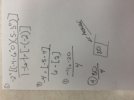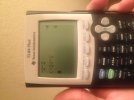I got -20 as well. At the beginning of the problem, is it written as -2^... or (-2)^...? These notations essentially mean "2 raised to x power, multiplied by -1," OR "negative 2 raised to x power." Hope this helps.-2^2 [(- 4- 6^0 )(5-3^0 )] / | -6 |- [ -( -2)] Can anyone solve this. I keep getting -20 but the answer book on the online ASTB sample questions says the the answer is 20.
-
Please take a moment and update your account profile. If you have an updated account profile with basic information on why you are on Air Warriors it will help other people respond to your posts. How do you update your profile you ask?
Go here:
Edit Account Details and Profile
You are using an out of date browser. It may not display this or other websites correctly.
You should upgrade or use an alternative browser.
You should upgrade or use an alternative browser.
ASTB-E/APEX 4 Experience -DEC 2013
- Thread starter Notorious Nate
- Start date
speedroller
Rangers
Math: This section was true to the math section overview on the NMOTC website.
Can you please provide the link? I googled that name, but I could not find anything in particular. Thanks!
RMP
Looks good to me
Can you please provide the link? I googled that name, but I could not find anything in particular. Thanks!
http://www.med.navy.mil/sites/nmotc/nami/Pages/ASTBOverview.aspx
Flyboy8924
New Member
Exactly. The issue is with the notation of the "-2^2." The -20 vs 20 comes from whether or not the question is asking for "-2^2" or "(-2)^2."This is what I came up with (20).
Just took the ASTB today, and wanted to share my experience, as well as offer thoughts on study materials. I won't go into too much detail, as there is already a lot of good info in this thread. 62/8/8/8
Math: This section was true to the math section overview on the NMOTC website. It included a lot of probability questions, as well as simplification problems. What I mean by that is something like: "simplify the following equation: -3 [-4+5(5-4)] + -3." I also encountered a few questions asking to find the missing number in a pattern e.g. "1,3,5,8,10 _." This section ended very quickly for me. There could have been more than 15 problems.
Reading: no advice here, other than using the process of elimination to rule out statements that are not the best fit.
Mechanical Comprehension: Lots of pulley questions, as well as questions about levers and the force required to move them. Know your electrical, as there were a few of these questions as well.
Aviation/Nautical Information: This section will kill you if you don't know basic aviation information, like how an airfoil creates lift. There were several questions related to that alone. Know your airplane terminology and what it means (e.g. critical angle of attack, chord line, stall). Having flight experience is invaluable here; I actually had to use the knowledge I learned to get my PPL!Know the parts of a ship (freeboard, draft, gunwale, windlass). There were also some questions about naval/aviation history and specific airplanes. Actual question: "Which airplane was the main torpedo bomber used in WWII that flew for 15 years in the Navy?" I encountered no weather questions in this section.
Performance Based Measures: If you practice, the UAV map orientation part will be easy. I practiced until it became second nature, and only missed two. However, the joystick/throttle section was not! This was a real mindfuck. I felt like my head was going to explode the entire time; I was mentally exhausted afterwards! This is covered well elsewhere on the site. I must stress that it will feel like you are doing terribly with the joystick/throttle movements. Don't let this discourage you! Focus on the accuracy of your listening, button pushing, and emergency procedures, and you'll be fine. I don't see how anyone could prepare for this, other than by playing flight simulators. Even then, it wouldn't be very applicable practice. I felt like some of my flying experience helped with this in the way of being able to manipulate controls while listening to, and interpreting, information.
As far as studying went, I used Peterson's Officer Candidate tests - 9th Edition, Barron's Military Flight Aptitude Tests - 2nd Edition, Peterson's Military Flight Aptitude Tests - 8th Edition, and Barron's Mechanical Aptitude and Spacial Relations Test - 2nd Edition. ALL of these left me unprepared for the math section. You'll need to give special attention to all the items listed on the NMOTC website's overview. However, Barron's mechanical aptitude book WAS helpful with the mechanical comprehension portion of the test. I also felt like all of the books did a good job in helping me prepare for the aviation/nautical information section. In addition, there are some very helpful practice tests earlier in this thread for the UAV part of the performance based measures section that I highly recommend using.
Do not hesitate to ask questions, I'll be happy to answer if I can. Good luck!
RMP, what were the nature of the electrical questions? Were they problem solving types, or more theory based?
RMP
Looks good to me
One showed a diagram of a circuit, and asked some questions about resistance, volts, and amps at various points in the circuit. Wish I could give you an example, that's all I've got!RMP, what were the nature of the electrical questions? Were they problem solving types, or more theory based?
Sundevil106150
Well-Known Member
http://www.med.navy.mil/sites/nmotc/nami/Documents/ASTB_SampleQuestions_13May14.pdfI got -20 as well. At the beginning of the problem, is it written as -2^... or (-2)^...? These notations essentially mean "2 raised to x power, multiplied by -1," OR "negative 2 raised to x power." Hope this helps.
hey here is the link for the problem. Its question 1 on the math section. Also any ideas on 10 to solve it faster?
Sundevil106150
Well-Known Member
-2^2 is positive 4 not -4. -2x-2 =4. How did you get -4. Even if it were -(2)^2 or (-2)^2 it would be positive 4.This is what I came up with (20).
RMP
Looks good to me
I get -20 as well... maybe the sample answer is wrong-2^2 [(- 4- 6^0 )(5-3^0 )] / | -6 |- [ -( -2)] Can anyone solve this. I keep getting -20 but the answer book on the online ASTB sample questions says the the answer is 20.
Flyboy8924
New Member
-2^2 is positive 4 not -4. -2x-2 =4. How did you get -4. Even if it were -(2)^2 or (-2)^2 it would be positive 4.
Attachments
This is wrong. -(2)^2 is the same as saying -(2^2). The negative is not included within the parentheses. When one writes -2^2 without parentheses, the notation means it is positive 2 squared, times negative one. If you want to include the negative, it must be included in the parentheses. i.e. (-2)^2, which means negative 2 squared.-2^2 is positive 4 not -4. -2x-2 =4. How did you get -4. Even if it were -(2)^2 or (-2)^2 it would be positive 4.
-2^2 = -1 x (2 x 2) = -4
(-2)^2= -2 x -2 = 4
Sundevil106150
Well-Known Member
How is -2^2 still a negative?
Look at the edit I just made to my post, it may help.How is -2^2 still a negative?
Sundevil106150
Well-Known Member
Got it thanks guys I appreciate it. Take the exam tomorrow. Any way you guys can help on 10 too on the link I have?This is wrong. -(2)^2 is the same as saying -(2^2). The negative is not included within the parentheses. When one writes -2^2 without parentheses, the notation means it is positive 2 squared, times negative one. If you want to include the negative, it must be included in the parentheses. i.e. (-2)^2, which means negative 2 squared.
-2^2 = -1 x (2 x 2) = -4
(-2)^2= -2 x -2 = 4


